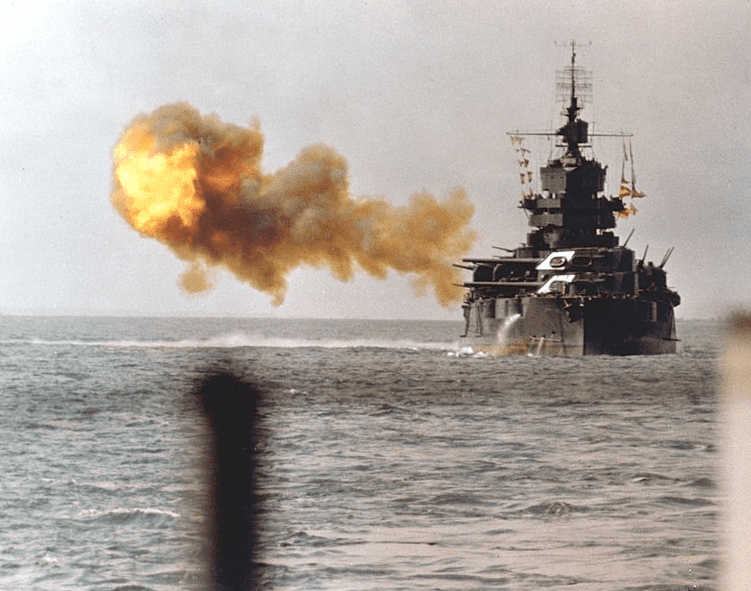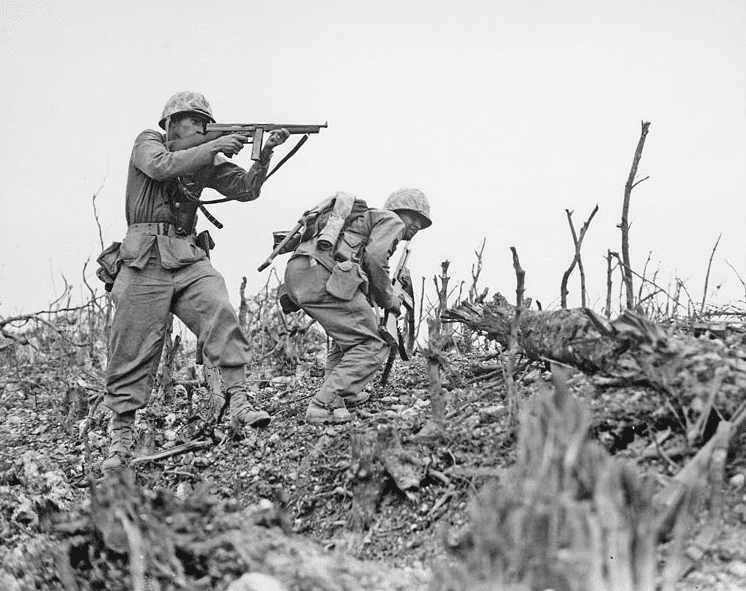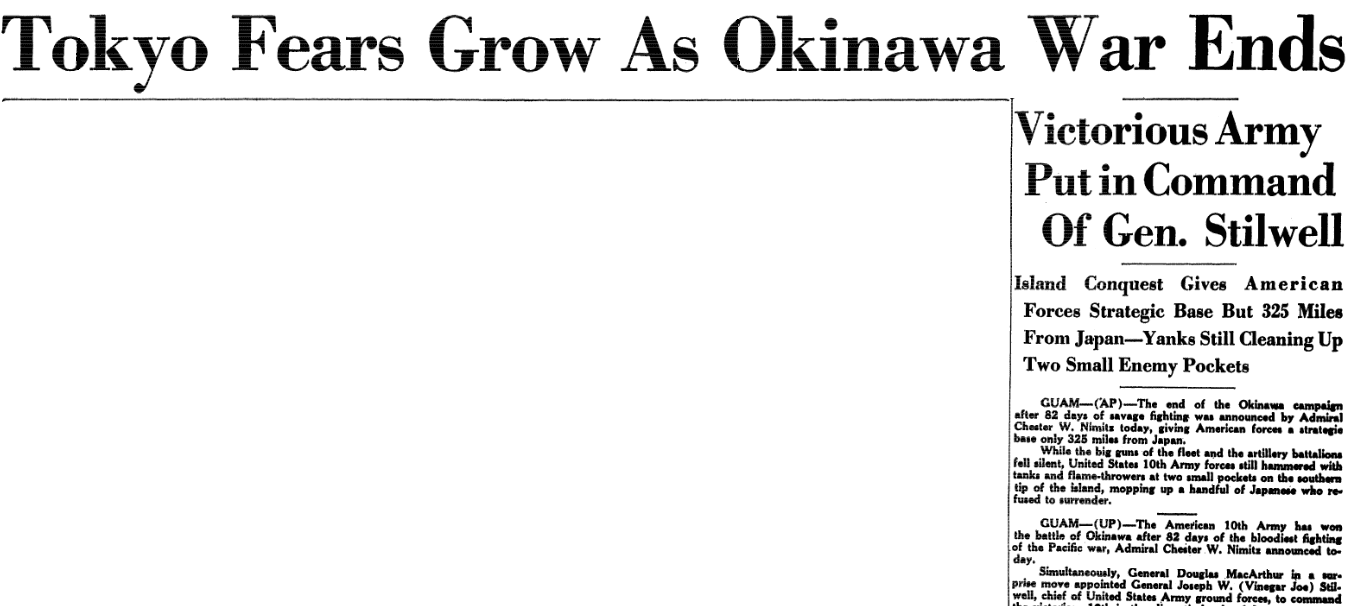On 21 June 1945, after 82 days of some of the fiercest fighting of World War II, the Battle of Okinawa finally ended with the complete destruction of a Japanese army numbering over 100,000 troops. While suffering over 50,000 casualties themselves, the Allies gained an important victory and secured a strategic base for the planned invasion of the Japanese homeland.

American troops did all the land fighting during the battle, supported by American naval and air forces supplemented by British ships and planes. Halfway through the battle, on May 7, came the news of the Nazi surrender (“V-E Day” – Victory in Europe Day – was proclaimed for May 8, when Berlin ratified the surrender). However, the Allies understood that Germany’s surrender would not impact the Japanese forces’ determined resistance.
The fighting during the Battle of Okinawa was savage, much of it hand-to-hand, as the Japanese troops knew the loss of Okinawa would leave Japan itself vulnerable to attack. Civilians on the island were caught up in the fury, and over 100,000 of them died – some by committing suicide.

As the following newspaper report of the Allies’ victory makes clear, everyone assumed the captured air bases and staging areas of Okinawa would be used to launch the invasion of Japan, and the Japanese resistance on Okinawa gave the Allies a grim indication of the fighting that lay ahead.
However, that invasion of the Japanese homeland never happened, for on August 6 and 9 the cities of Hiroshima and Nagasaki were destroyed by the horrific power of atomic bombs. Realizing further resistance was futile, Emperor Hirohito gave a radio address to the Japanese people on 15 August 1945, announcing the surrender of Japan. Eighteen days later, the formal surrender ceremony took place in Tokyo Bay on the deck of the U.S. battleship Missouri on 2 September 1945.

Here is a transcription of this article:
Tokyo Fears Grow as Okinawa War Ends
Victorious Army Put in Command of Gen. Stilwell
Island Conquest Gives American Forces Strategic Base but 325 Miles from Japan – Yanks Still Cleaning Up Two Small Enemy Pockets
GUAM – (AP) – The end of the Okinawa campaign after 82 days of savage fighting was announced by Admiral Chester W. Nimitz today, giving American forces a strategic base only 325 miles from Japan.
While the big guns of the fleet and the artillery battalions fell silent, Unites States 10th Army forces still hammered with tanks and flame-throwers at two small pockets on the southern tip of the island, mopping up a handful of Japanese who refused to surrender.
GUAM – (UP) – The American 10th Army has won the battle of Okinawa after 82 days of the bloodiest fighting of the Pacific war, Admiral Chester W. Nimitz announced today.
Simultaneously, General Douglas MacArthur in a surprise move appointed General Joseph W. (Vinegar Joe) Stilwell, chief of United States Army ground forces, to command the victorious 10th in the climactic battle of Japan.
Radio Tokyo said the United States apparently already has begun preparations for a “direct invasion of the Japanese mainland.”
Nimitz’s brief, triumphant communique reported that all organized Japanese resistance on Okinawa, hard-won stepping stone island only 330 miles southwest of Japan, ended today.
“Remnants of the enemy garrison in two small pockets in the southern portion of the island are being mopped up,” the communique said.
Only yesterday marines and doughboys of the 10th Army had split diehard enemy remnants into three separate death pockets. Nimitz’s announcement indicated one of the three pockets since had been wiped out and the others reduced to impotency.
Total Japanese casualties were not announced immediately, but they were believed well above the 90,000 mark. A total of 87,343 Japanese dead had been counted through Tuesday and 2,565 other enemy troops had surrendered.
American casualties have not been tallied for publication since May 24. Then they totaled 35,116 in the army, marine corps and navy, including 9,602 dead.
It was a costly campaign for the United States Fleet as 31 ships, mostly smaller units, were sunk, and 54, including four large units, were damaged.
At that time the American casualties already had exceeded those suffered in the invasions of Tarawa, Iwo and Saipan, previously the most costly in the Pacific campaign.
Conquest of the island gave the Americans an island base 60 miles long with a number of air bases and sufficient ground area to deploy hundreds of thousands of troops for the invasion of Japan.
The return of Stilwell, one of America’s most experienced Far Eastern warriors, to a field command for the big Pacific battles to come was announced by MacArthur in Manila in his new capacity as commander of all army forces in the Pacific.
Okinawa at present is under the overall operational command of Admiral Chester W. Nimitz, but MacArthur’s new post leaves the selection of local army commanders to him.
Stilwell will succeed Lieutenant General Simon Bolivar Buckner Jr. who was killed in action on Okinawa only Monday as he watched his forces carve up the Japanese remnants in the final phase of the campaign.
With the battle of Okinawa now officially concluded, Stilwell can concentrate on readying the combat-tested 10th Army for the next stage of the Pacific war. A Manila dispatch said it was a virtual certainty that he would be one of the top commanders for the conquest of Japan.
Radio Tokyo said informed quarters in the Japanese capital reported American preparations underway “for their next operations, which in all probability will involve direct invasion” of Japan.
Tokyo cited these signs of American intentions:
- B-29 raids on small as well as large Japanese cities point to an attempt to destroy the country’s transportation network and factories in a prelude to invasion.
- More than 100 American transports are at anchor in the American-won Kerama Islands southwest of Okinawa and two naval task forces have appeared near Miyako Island, farther southwest.
- General Douglas MacArthur’s establishment of a western Pacific command indicates that large bases are to be set up for the assembly of personnel and material for an invasion of Japan.
Note: An online collection of newspapers, such as GenealogyBank’s Historical Newspaper Archives, is not only a great way to learn about the lives of your ancestors – the old newspaper articles also help you understand American history and the times your ancestors lived in, and the news they talked about and read in their local papers. Did you or any member of your family serve during World War II? Please share your stories with us in the comments section.
Related Articles:
